By Jeffrey A. Rendall, Photos By Jeff Janas
WINTERGREEN, VA – In June, a little bit ‘o Canada’s coming to central Virginia, and we’re not just talking about vacationing NHL players invading after the Stanley Cup’s been fought over and won.
For the second consecutive year, Wintergreen Resort will host the Canadian Pro Golf Tour’s Lewis Chitengwa Memorial Championship at its Stoney Creek Golf Club (June 7-13), down in the valley below the Resort. Last year’s event, held in the heat of August, was won by American Nick Watney with a score of 20-under par for the four day tournament.
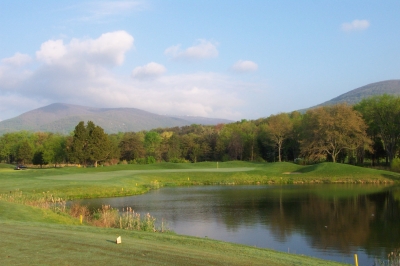 |
| The par three 8th hole at Wintergreen's Tuckahoe nine. |
In case you’re unfamiliar with the Canadian Tour, it’s populated with extremely talented players hoping to play their way up (or back) to the PGA Tour, and its alumni includes current ‘big’ Tour participants Mike Weir, Stuart Appleby, Chris DiMarco, Steve Stricker and long-ball hitter Hank Kuehne. Despite the name, the Canadian Tour plays over half its schedule ‘south of the border,’ with nine events in the United States and even a couple in Mexico.
In other words, though it may sound a bit odd to be playing the Canadian Tour in Virginia, it’s not the least bit unusual to see Canadians pro golfers on US soil. In fact, it’s for a very good cause.
Mike Mayer, Wintergreen’s Director of Golf, says there’s a higher purpose for hosting the event: “When Mike Moraghan (University of Virginia’s Golf Coach) contacted us about potentially hosting the Lewis Chitengwa Memorial Championship, we saw it as a great opportunity to showcase our golf here at Wintergreen, but also to help grow the game in Lewis’s memory.”
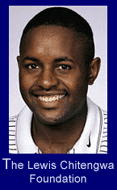 |
| Lewis Chitengwa would've been proud that much good work continues in his name. |
Hailing from Zimbabwe, Chitengwa was a special person as well as a talented golfer. The first black player to win the South African Amateur Championship, even at a young age he’d established himself as an international budding star when Moraghan convinced him to attend and play at the University of Virginia (where he was a very successful college player). As an example of Chitengwa’s talent, he beat Tiger Woods by three strokes to win the 1992 Orange Bowl World Junior Tournament in Miami.
Not many can say they’ve beaten the world’s best player as an amateur.
Tragically, Chitengwa suddenly passed away in 2001 while playing on the Canadian Tour – but his legacy is kept alive through events such as the tournament played in his memory. The competition benefits the Lewis Chitengwa Foundation, which Moraghan established in Lewis’s name to continue his mission – to help underprivileged children gain access to educational and athletic opportunities that they otherwise might not have.
 |
| Click on the banner to book a tee time at Wintergreen and other Central Virginia Golf Courses. |
As it turns out, Wintergreen got the event because Coach Moraghan wanted to keep it in the Charlottesville area, close to where Chitengwa went to school: “The Chitengwa event was first held at Keswick Club in 2002, and last year, Moraghan came to us looking for another possible site. Keswick’s a very nice golf course, but it’s a bit short for players of the caliber they have on the Canadian Pro Tour. To toughen the course, they let the Keswick rough grow pretty long, but the players still tore it up – those guys hit the ball long and straight,” Mayer added.
Those Canadian Tour professionals did the same thing to Stoney Creek’s Monocan and Shamokin nines (the original layout, later joined by the Tuckahoe nine) last year, setting a new course record and having the winning score dip to 20 under par. For those familiar with Wintergreen’s Rees Jones (the ‘Open Doctor’) designed Stoney Creek, that’s pretty impressive.
The Canadian guys can play, too – and highlights the extremely fine line between making it on the PGA Tour, and paying your dues on some of the world’s smaller golf stages. Mayer says, in his course’s defense, that last year’s steady rain left Stoney Creek’s greens somewhat defenseless.
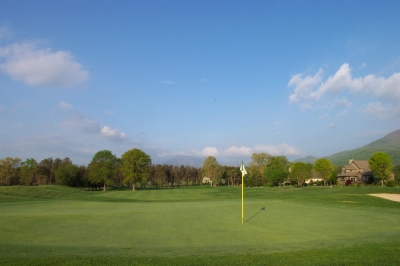 |
| It'll end here at the Shamokin nine's 9th hole (18th for the tournament). A fitting closing hole -- you'll need precise placement on drives and approach shots to make a good score. |
“Because of the tremendously wet summer we had in 2003, the greens were very, very soft – and when the putting surfaces get like that, those professionals are very aggressive, just throwing the ball right to ‘em. We’ll grow the rough up again, like last year, but other than that, we don’t do a whole lot differently to the course than normal,” Mayer said.
The superintendent might not do much different, but Wintergreen’s membership really gets involved. The event is offered free of charge to the public, and parking’s free too – so they expect a good-sized crowd. Mayer says the members are out there at 5:30 in the morning raking bunkers and making sure everything’s in perfect shape for the Tour pros. They’ll also be out on the course after the conclusion of play every day, filling divots ‘til it’s too dark to see.
That’s the nice thing about getting a chance to see great golfers play in a community environment – the patrons care about making sure their course is in great condition for the world to see. Just that little bit of extra TLC goes a long way.
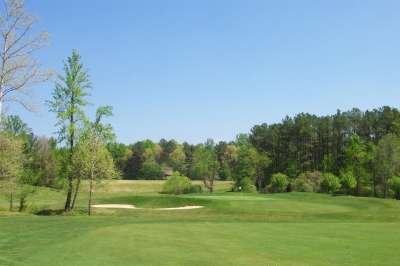 |
| You can't see it from this shot, but the Tuckahoe nine's par five 3rd hole is a roller-coaster ride from tee to green. It's not bad looking, either. |
One maintenance area where Wintergreen will do something special is with the greens – trying to get them to quicken and firm up a bit. Mayer elaborates: “For that week, we’ll put our greens under tournament conditions stress. Every time there’s a professional tournament, the superintendent’s just praying to get a little bit of rain and that it’s cool in the evenings, which will give the grass you’ve just double-cut and rolled a little bit more release. Unfortunately, the Tour officials are saying the opposite -- ‘gosh, I hope it doesn’t rain and the greens get to be rock hard and scary fast.’”
The course will actually be set up (as you’d expect) by the Canadian Tour – meaning you’ll see some pin placements that wouldn’t normally be suitable for resort or member play. Mayer said it was interesting to see how they did it last year, and it wasn’t always as he’d expected it.
“The Canadian Tour officials said you might think they save all the tough pin placements for Sunday, but they don’t. You’ll typically find Friday to be a bit more difficult because they’re trying to separate the field so they can make a cut – and they don’t want everyone bunched in there together,” Mayer explained.
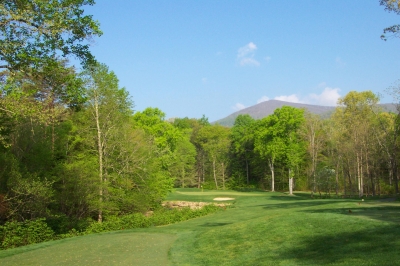 |
| A beutiful and challenging par three -- Shamokin's 3rd hole. |
That’s not to say it wasn’t difficult everyday. “I was surprised that on Shamokin #6 (#15 for the tournament), which is a beautiful hole with the creek running in front of the green – they had four pin placements on that green, and all four were about four paces from the edge of the creek. They had hard, harder, hardest – those were the pin placements. Needless to say, we’ll use more of the green for everyday play,” Mayer joked.
It’s difficult to contemplate what it must be like to maintain operations before, during and just after hosting professional events, but Wintergreen’s experienced at it. Even during the tournament, the Devil’s Knob course at the top of the mountain will remain open, and the Stoney Creek links won’t miss a beat in the days prior to the pros’ arrival or after their departure.
Playing Lesson with the Wintergreen Pro
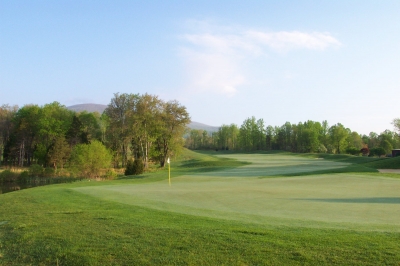 |
| Looking back at Tuckahoe's 7th green and fairway -- you've reached flat ground here, but you've just been up in those hills, too. |
Another constant at Wintergreen is the Golf Academy, which we visited two years ago (June, 2002) – studying under the tutelage of head instructor David Bartholomew. We took the two-day school, where Bartholomew thoroughly presented the fundamentals of the golf swing and took us through a very cerebral treatment of the game of golf.
One part of the school that we didn’t choose to take advantage of at that time (as recommended by Bartholomew, himself), was a playing lesson. Bartholomew cautioned against taking a playing lesson while attending the school, because to put it simply, your head’s ‘too full’ with ideas to make it productive.
“When I took over the school, we actually eliminated the playing lesson as part of the program,” Bartholomew explained. “When people come here and start making changes to their golf swings, the mind really takes over and becomes very mechanical. I just don’t think it’s productive to go out on the golf course and talk strategy when you’re thinking about something else.”
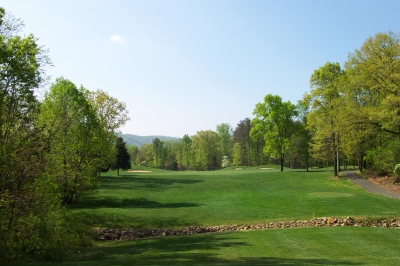 |
| Shamokin's 8th hole is a dogleg left par five that should provide a good birdie opportunity to the professional who can shape a draw from the tee. |
This time, we had no problems fulfilling the requirements for ‘empty head syndrome,’ so Bartholomew made good on his promise to take us for that long awaited playing lesson.
After watching numerous television-produced ‘playing lessons’ on the Golf Channel, Bartholomew’s was similar in structure and presentation. He’d give an overview of the hole, suggest the proper thought process, and tell us to ‘play away.’
But unlike what you see on TV, the results presented many good situations for further discussion and instruction.
 |
| The mountains in the background dominate the scene -- but the mounding on Tuckahoe's par five 9th hole suggests the shot to hit from the tee. |
“I’ve noticed too many times that players arrive at the first tee, not having warmed up, in a hurry to make their tee times, and the results are predictable. I always counsel students that preparation to play golf begins well before you even come to the golf course, where you’re trying to slow down your motions and provide for as little tension as possible,” Bartholomew said.
He stressed that you need to have a ‘plan’ for every shot – that proper execution can only come from first, assessing the situation, choosing what you’d like to do, selecting a precise target, than letting your swing do the rest. Golf is about moving your golf ball around the golf course in the least number of strokes – it’s not necessarily blasting a driver on every tee.
It’s a mental process, or lack thereof -- forgetting about the results of the previous try and moving on to the next shot.
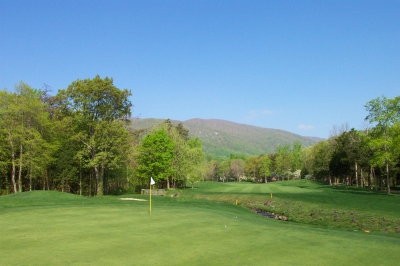 |
| Shamokin's 6th hole -- Mike Mayer says the pin will be up front all four days for the Canadian Tour players. |
“After you’ve hit a shot, it’s time to start thinking about the next one. You can’t do anything about the one you just hit, so it doesn’t do any good to dwell on it, one way or the other. If there’s one thing I see from my students, it’s the fact they’ll be so upset from what happened with the previous shot or hole that they’re already in the wrong frame of mind to go onto the next one. If they’re angry about something that happened three holes ago, that’s not helping them play the current one any better,” Bartholomew lectured.
He continues, “Keeping a positive frame of mind is critical to playing good golf – because once again, if you’re thinking about anything other than what’s in front of you, then tension creeps back into the picture. And what kills the golf swing….??? Tension.”
Bartholomew’s the antithesis of tension. He’s so laid back and fluid he’d be a good body double for Spider Man. And he’ll tell you like it is, too.
 |
| Click on the banner to book a tee time at Wintergreen and other Central Virginia Golf Courses. |
“A lot of the people I’ve worked with, then went out on the playing lesson – it was kind of like a ‘watch me’ do it situation. I don’t agree with that philosophy. It’s about you, not me. I’ll hit some shots alongside you, but we’re here to talk about what you’re thinking,” he said.
A lot of times, it’s the wrong thing. “I’ve played with enough people that hit it into the woods -- and instead of just taking your wedge and hitting it out, they’ll try the one in a million shot. So their four or five or six becomes an eight, nine or ten. That’s just plain stupid,” Bartholomew said.
Taking a playing lesson is a worthwhile venture, even if you’re not always executing your ‘plan.’ You’ll see the architect’s design intentions much more clearly, go into each shot with a specific thought in mind, and instead of flailing away and hoping for the best, you’ll play your next golf game with a much narrower vision. Will it improve your scores? That’s up to you. But if you’ve learned your playing lessons well, you’ll have more fun and improve.
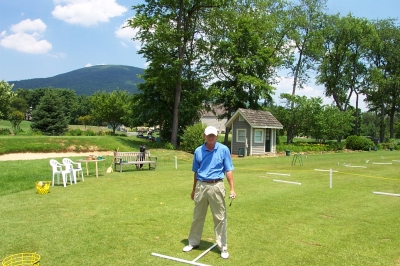 |
| David Bartholomew of the Wintergreen Golf Academy will set your game -- and your strategy -- right if you give him a shot. |
Note: For full treatments on Wintergreen Resort, the Golf Academy and individual course reviews of Stoney Creek and Devil’s Knob, please see the links below.
Many thanks to Wintergreen members Karen & Carter Asher for their tolerance and good senses of humor.
Details:
Wintergreen Resort
The Lewis Chitengwa Memorial Championship (June 7-13, 2004)
Canadian Pro Golf Tour.
Monday, June 7 – Open Qualifier and practice rounds.
Tuesday, June 8 – Pro Am.
Wednesday, June 9 – Practice rounds.
Thursday, June 10, and Friday, June 11 – Begins at 7:30 am from 1st and 10th tees.
Saturday, June 12 and Sunday, June 13 – Begins at 7:30 am from 1st tee.
No charge for spectators and parking is free. For more information, call 434-325-8255 or visit http://www.wintergreenresort.com/.
| Related Links | Comments on this article? | |
|
Maryland National Golf Club Hollow Creek Golf Club Rocky Gap Resort PB Dye Golf Club in Ijamsville Whiskey Creek Golf Club |
E-mail Jeff Rendall, Editor: jrendall@golftheunitedstates.com |











